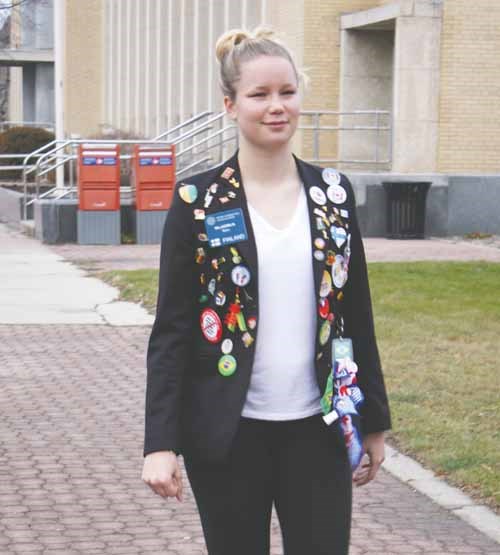Rotary is well-known for its community service. Locally, fundraising efforts and volunteer labour builds parks and community facilities, provides disaster relief and contributes to charity.
Internationally, Rotary takes on even bigger projects. For example, the club has raised more than $850 million to eradicate polio in the developing world.
Perhaps lesser known, is the organization's cultural activities. Every year, thousands of young people get to travel abroad through Rotary's Youth Exchange.
Miljaemilia Wala, a 16-year Grade 11 student from Finland is currently in Yorkton thanks to the program. Here she is known simply as Millie.
Two years ago, she decided she wanted to spend some time overseas. She looked at various options, but they were all too expensive. Then her mother, a flight attendant with an airline found Rotary.
The only thing was she would have to compete for it. There is an application letter and interview that explores why the youth wants to travel and what they will bring to the table in terms of being an ambassador for their country abroad. It also takes into account things like the student's grades.
"Other programs basically anybody gets to go because it's about money," she explained. "If you have money you can go, but with Rotary, you have to be the right kind of person."
Millie was nervous about her chances.
"All of the girls, the four of us, had really good grades," Millie said. "Our school system is out of 10 and I had about 9.5, but I still wasn't sure.
"I was pretty sure I won't make it because all of us were really good, but then I got the information that I would be the one and that was pretty awesome."
She did not realize until she got to Canada, how lucky she was to get hooked up with Rotary.
"It's way better," she said. "What I've realized now, because there's another exchange student in the school and she's not with Rotary, and we have way more trips to go with other exchange students in this district and so many people around you like Ray [Bailey], my counselor and the house families."
Although the program accounts for room and board, as well as a little spending money, participants are responsible for their own airfare and associated costs such as visas.
Daughter of a single mom who works for an airline, Millie got a bit of a break on the airfare, but had to work two summers to put the money together.
"Here it is much common for young people to have jobs when they have school, but back home school really takes a lot of time and you really don't have time to work because you have so much homework," she said. "And it's so much harder just to get jobs back home. You have to be 18 to work anywhere like the Superstore or anywhere because grocery stores they sell alcohol and cigarettes so you have to be 18 to sell them."
Other differences she has found are with school itself. In Finland, school is divided into elementary (Grades 1 to 6), junior high (7 to 9) and high school (10 to 12). After Grade 9, students choose whether they will follow an academic path, which leads to university or technical and go into the trades.
Millie was surprised to find the two milieus mixed at YRHS.
She also finds school here to be much more laid back.
"It's slower; you don't do that much in a class," she said. "If it would be the same here as back home, it would be really hard for me because it's in another language so it would be really hard. It's hard now because of the language, but the school isn't hard."
Millie is on the path to university, which at this point looks like it will be in Finland.
"I'd love to go somewhere else, but the university costs so much everywhere else, but back home it's free," she explained.
Her biggest fear coming over was that she would be ignored.
"Last year I was in school and there were exchange students and I didn't notice until Christmas time that they were there," she said. "I thought, oh my God, what if that's going to happen to me, that nobody is going to know that I exist, but I was so surprised that everybody were, 'you're the exchange student'. I like the people here, the people are so nice, so open and welcoming and kind of laid back."
Still, her favourite part of the adventure so far is going on trips with other exchange students throughout the region. The last time was to Minnedosa at Halloween.
"So we have like a family and we were so sad because next time we're going to meet is in January, it feels so long time until January," she said.
Since her mother travels a lot, Millie is used to being independent and hasn't really experienced much homesickness, although there are exceptions.
"I don't really miss home yet, but I miss some things," she said. There's this rye bread… you have rye bread here, but it's not rye bread like our rye bread, it's black and it's so good and it's so healthy and it tastes awesome."
She also misses the soup in Finland.
"The soup here is so weird," she said. "I've never put crackers in my soup before and there's weird things in it, like peas. They're not bad, but they're weird."
Rotary has been running the international exchange program since 1927.




